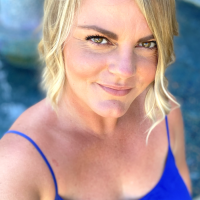I don’t know if it’s that still not enough people talk about it or if it’s the algorithm or what.
But there’s a certain type of body that I still don’t see represented in the body positivity movement—and it’s mine. And also, maybe yours.
Years ago, I remember starting to see talk about needing more representation of normal bodies in advertising and fashion. At a semi-toned 135 pounds on a 5’4” frame, I remember my aunt encouraging me to go try out for America’s Next Top Model—after the first “plus-sized” person, Whitney Thompson, had won despite not looking at all plus-size to me.
She wore a size 10 back then, in 2008. The dress size of the average American woman, today, is a size 16.
Here’s what I’m not seeing when I walk around a mall, or peruse through Fabletics’ online catalog:
Average people.
Not model thin, but also not 2X plump.
Not flat-chested, but also not D cups or above.
Soft, but not curvy.
Athletic, but not toned.
Asymmetrical faces.
Imperfect, less than Crest-white smiles
Texture on the skin or sun spots.
Crows feet newly imprinted on the outside corners of a 30-something’s eyes.
Cellulite and stretch marks not smoothed over by a filter or an airbrush or creative lighting.
Double chins.
Average people.
Not Selena Gomez with no photoshop in just her bikini, or the great lighting on Demi Lovato’s artistically framed naked backside. These people are still the exception; they’re famous, have often been professionally trained how to pose to flatter their bodies as best possible, and have photo crews to pose and direct them when they miss their mark.
Average people.
Not Instagram body-pos influencers who teach the posing tips and tricks and then show reality.
I could go on in my rant, but why?
What’s an average woman to do? I’ll tell you:
The answer doesn’t lie in seeing my 5’4”, 177-pound athletic build with a minimal waist-to-hip ratio, B- or sometimes C-cup breasts, an asymmetrical face dotted with sun spots, and never-braced teeth reflected on posters of other women standing in cute panties or a skimpy bikini. If I’m honest, I don’t want to see that—and that’s what I’m getting to, here.
While I understand that a lack of representation is a part of what perpetuates negative self-image, it’s not the main player: we are.
The problem with the body positivity movement is that we have a lot of folks talking about the shiny confidence they have in their stretch marks or their cellulite, but when we look at the “others” who are now coming to be front and center in this movement, there’s still something striking about their bodies—something “different.”
We’re still admiring models with sparkling eyes, luscious lips, the right body proportions to pass as having those longed-for long legs in images—and pose-away-able or photoshop-able cellulite and stretch marks.
If we’re not admiring those influencers, we’re likely to be captivated by exceptionally (or at least bigger-than-average) large women who are often fetishized.
The middle—the average—remains unacceptable, unseen. We average folk keep on admiring others and in doing so, other ourselves. We see the thinner, longer-boned influencers’ confidence in their skin and see something better in its creases. We see the larger influencers and admire their kick-ass ability to flaunt it all and somehow look better than we do while doing so. Maybe we wish we could be either thinner or much larger—just something other than what we are. I know I’ve found myself in that boat.
And so I’ll pose a few questions:
Would you like to see your body in ads—like, really enjoy looking at it? Would you pore over a fashion magazine and admire—truly admire—the bodies that look like you?
Do you feel that you’d see someone else with your body type represented in a store’s most recent branding campaign, and in one quick glance or a hundred, suddenly feel sexy in your own skin just because a company decided to sink its teeth into your insecurity and represent you so you’d buy their garments or products?
The problem with the body positivity movement is that it needs to offer us actionable steps and psychological tools to help us love our bodies.
Reading about how some woman across the globe loves her tiger stripes ain’t gonna cut it—nor will her 1,000 encouraging “love your body” calls to action.
Seeing our bodies reflected back to us in ads and online might help us to feel a bit more comfortable and seen, but it won’t help us to truly accept our skin suit, to find it—ourselves—appealing, desirable, or worthy.
What the body positivity movement so often misses is that self-love is an end goal—not the remedy, not even a step. And this, my friends, is where I am lost:
Where do we start when we look at our bodies and can’t say a positive thing about our half-naked aesthetic?
Where do we start when we read those influencer remarks that claim to adore their stretchies or cellulite and wonder how that’s even possible, and if that’s real or just a mantra they’re repeating until they magically believe it?
How do we begin to bring our acceptance and fascination or admiration of other bodies home into ourselves without necessarily focusing on a change to our bodies that might help us do so?
If you’ve got that personal experience or the professional expertise, goddamn do I wish you’d write it up!
But I guess you could always start in the comments.


 Share on bsky
Share on bsky





Read 20 comments and reply